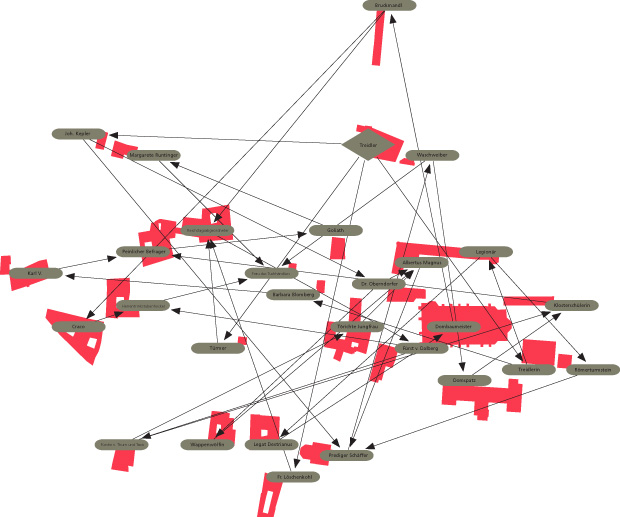

|

RexPlorer
REXplorer is a pervasive game that helps visitors to explore the history of Regensburg, Germany. In the game, historically based spirits are stationed at points of interest throughout the city. Players use a special “paranormal activity detector” (a device composed of a mobile phone and a GPS receiver in a protective shell) to interact with location based and site specific spirits. A novel mobile interaction mechanism of “casting a spell” (making a gesture by waving the wand-like detector through the air) allows players to awaken and communicate with spirits to receive and resolve quests.
- REXplorer is designed to extend the visitor experience beyond the museum walls, showcasing the most significant attraction of Regensburg: its mostly gothic and Romanesque urban silhouette and architecture.
- REXplorer is a joint research project between Media Computing Group der RWTH Aachen and the department of Computer Aided Architectural design of the Swiss Federal Institute of Technology Zurich for the Experience (REX) museum in Regensburg.
- REXplorer is a continuous research project focusing interactive urban space (urban computing) & interactive architecture, mobility steering and a mobile portable radio-based man-machine interaction. REXplorer used e.g. as the first game of this kind local based haptic interaction with a "magic wand" (a Smart phone in a casing) as input method.

Game Overview
Visitors are asked, as scientific assistants, to examine paranormal activity recently discovered outdoors in the Regensburg medieval city core within one hour. For field research, the scientists have developed a special detector device that is able to measure paranormal activity at specific sites in the city core. The detector has artificial intelligence, similar to a magic wand, and is able to talk directly to the players. This makes the device a character in the game, encouraging players to anthropomorphically relate to it as a team member helping them achieve their goals. The detector reacts to a variety of game play situations, for example when the player idles for a longer time. Most importantly, the detector notifies players when they are in the vicinity of paranormal activity (and a point of interest) through it’s own excited heartbeat, further emphasizing its human qualities. To make the detector character even more accessible, and entertaining, its voice acting is highly expressive, excited, and often self-ironic. During the game, the player’s progress is tracked and used to create a personalized souvenir geo-weblog (blog). The player blog documents the player route over space by interfacing with Google maps and over time by chronologically listing all sites and characters the player has interacted with during her session. The blog provides de-briefing web links concerning the characters appearing during game play to help the players learn more about the history behind the sites. During their game session, players can - and are reminded to- shoot pictures and videos of their field research. This image material is also automatically added to the blog with corresponding locations marked in the interactive map.
Research
The rapidly progressing technical fusion of mobile telephony, digital photography and handheld computer opens new horizons for mobile supported phone city guidance, which take place in the form of "city plays", in order to steer visitors via play from attraction to attraction. As world premiere in the framework of REXplorer Smart phones with gesture recognition are used for the first time, which consider the player position for the game flow by GPS and supplemented sensor technology. The individual game stations are linked together through stories, player challenges and exercises - a novelty in designing of interactive urbane space.
Further Information
Contact
Steffen P. Walz, E-Mail: walz_at_arch.ethz.ch
Team
Sponsors
Main developers & Project leaders
- Steffen P. Walz, ETH Zurich, Dept. Architecture, Chair for CAAD, Prof. Dr. Ludger Hovestadt: Concept & Game Design, Story / Script and Game Controller- processing leader
- Tico Ballagas, RWTH Aachen, Media Computing Group: Technical concept, interaction Design and software implementation
* Dr. Julien Biere, Regensburg Experience (REX) museum
- Prof. Dr. Jan Borchers, RWTH Aachen, Leader Media Computing Group
Research & Design Team
- PR and Marketing: Brigitte Weidmann, Regensburg Experience (REX) museum
- Contentwise Support: Regensburger Gästeführer / Matthias Freitag, Agentur Wissensräume / Dr. Roland Popp, Stadt Regensburg / Amt für Vermessung und Statistik
- Co-Drehbuch & Co-Charakterentwicklung: Alexander Möhnle, Stuttgart
- Game Controller-Gehäuseentwicklung: Claudia Fuhr und Martin Tann, ETHZ CAAD / MAS sowie beratend Christian Weber, www.plasmadesign.ch
- Project assistance & Research: Benjamin Dillenburger, ETHZ CAAD / MAS
- Audio production und Sound design: Jürgen Swoboda, Floridan Filmtonstudios Ludwigsburg
- Production assistance: Caroline Sexauer, Stuttgart, und Katrin Schöbel, Stuttgart
- Animation und Visual Design: Joel Mendoza, RWTH Aachen, Media Computing Group
- Szenographie und Intro/Outro-Production: Jan Stillhammer, Hochschule für Medien, Stuttgart sowie Joel Mendoza und Eugen Yu, RWTH Aachen, Media Computing Group
- Smartphone- Gesture recognition: Sven Kratz, RWTH Aachen, Media Computing Group
- Game- architecture: David Holman, Tico Ballagas, RWTH Aachen, Media Computing Group; Steffen P. Walz, ETHZ CAAD
- GPS-Tools: Jonathan Diehl, RWTH Aachen, Media Computing Group; Nick Burch, www.gagravarr.org; Christoph Wartmann, ETHZ CAAD
- Blog-Server: Johannes Fundalewicz, RWTH Aachen, Media Computing Group
- Blog content- Editing: Martin Tann, ETHZ CAAD / MAS
Speakers
- Patrick Heppt as " detector " and in historical and fabulous parts: Heiner Heusinger, Wolfgang Klar, Barbara Scherrer, Kathrin Hildebrand, Daniele Coscia, Sarah-Ann Kempin, Andreas Schmid, Frank Sollmann, Andrea Kümpfbeck, Arne Wittwer, Steffen P. Walz, Mandana Mansouri, Caroline Junghanns, Sarah Gruen, Didi Müller, Sonja Füsti, Daniel Frasch, Bojan Suman und Alexander Möhnle.
-- ChristophSchindler - 28 Jun 2007
|



